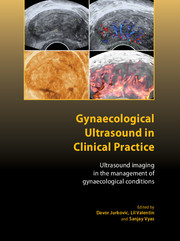 Gynaecological Ultrasound in Clinical Practice
Gynaecological Ultrasound in Clinical Practice Published online by Cambridge University Press: 05 February 2014
Introduction
Ultrasound is a versatile diagnostic tool that is of proven value in the assessment of women with gynaecological complaints. Transvaginal ultrasound has improved the ability of ultrasound to interrogate the pelvic organs with less interference from intervening structures such as gas or fat. However, it is not only the uterus and ovaries that are amenable to ultrasonic inspection. Other pelvic structures such as the bowel, renal tract or pelvic sidewalls are also readily seen. This is fortuitous, as symptoms arising from the pelvis are relatively nonspecific. The gynaecologist may, for instance, need to distinguish between the symptoms caused by pelvic inflammatory disease and those of an inflamed pelvic appendix. An awareness of alternative diagnoses and an appreciation of the normal and abnormal ultrasound appearances of bowel, bladder and other structures will help in achieving the correct diagnosis.
Transvaginal ultrasound, because of the ability to place the probe close to the region of interest, can better enable the diagnosis of pelvic disease. It allows an imaged bimanual palpation to occur, with the movement of tissues relative to each other seen and tender structures found. This can remove doubt so that other imaging modalities such as computed tomography (CT) are not needed. Transvaginal ultrasound also facilitates diagnostic and therapeutic intervention in the pelvis: guided needle biopsies or drainage of collections can all be achieved. This chapter aims to encourage the gynaecologist to look beyond the uterus and ovaries when imaging the pelvis.
To save this book to your Kindle, first ensure no-reply@cambridge.org is added to your Approved Personal Document E-mail List under your Personal Document Settings on the Manage Your Content and Devices page of your Amazon account. Then enter the ‘name’ part of your Kindle email address below. Find out more about saving to your Kindle.
Note you can select to save to either the @free.kindle.com or @kindle.com variations. ‘@free.kindle.com’ emails are free but can only be saved to your device when it is connected to wi-fi. ‘@kindle.com’ emails can be delivered even when you are not connected to wi-fi, but note that service fees apply.
Find out more about the Kindle Personal Document Service.
To save content items to your account, please confirm that you agree to abide by our usage policies. If this is the first time you use this feature, you will be asked to authorise Cambridge Core to connect with your account. Find out more about saving content to Dropbox.
To save content items to your account, please confirm that you agree to abide by our usage policies. If this is the first time you use this feature, you will be asked to authorise Cambridge Core to connect with your account. Find out more about saving content to Google Drive.